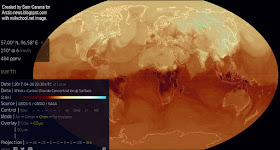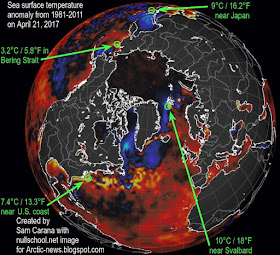On April 21, 2017, at 15:00 UTC, it was as hot as 46.6°C/115.8°F in Guinea, in West-Africa (at the location marked by the green spot on the map below).
That same time and day, a little bit to the south, at a spot in Sierra Leona, a level of carbon monoxide (CO) of 15.28 parts per million (ppm) was recorded, while the temperature there was 40.6°C or 105.1°F. Earlier that day (at 13:30 UTC), levels of carbon dioxide (CO₂) of 569 ppm and of sulfur dioxide (SO₂) of 149.97 µg/m³ were recorded at that same spot, shown on the bottom left corner of the image below (red marker).
These high emissions carry the signature of wildfires, illustrating the threat of what can occur as temperatures keep rising. Further emissions that come with wildfires are black carbon and methane.
Above image shows methane levels on April 22, 2017, AM, at an altitude corresponding to 218 mb. Methane at this altitude is as high as 2402 ppb (magenta indicates levels of 1950 ppb and higher) and while the image doesn't specify the location of this peak, it looks related to the magenta-colored area over West Africa and this looks related to the wildfires discussed above. This wasn't even the highest level recorded that day. While at lower altitudes even higher methane levels were recorded that morning (as high as 2505 ppb), above image illustrates the contribution wildfires can make to methane growth at higher altitudes.
The table below shows the altitude equivalents in feet (ft), meter (m) and millibar (mb).
| 57,016 ft | 44,690 ft | 36,850 ft | 30,570 ft | 25,544 ft | 19,820 ft | 14,385 ft | 8,368 ft | 1,916 ft |
| 17,378 m | 13,621 m | 11,232 m | 9,318 m | 7,786 m | 6,041 m | 4,384 m | 2,551 m | 584 m |
| 74 mb | 147 mb | 218 mb | 293 mb | 367 mb | 469 mb | 586 mb | 742 mb | 945 mb |
On April 26, 2017, CO₂ levels at Mauna Loa, Hawaii spiked at 412.63 ppm.

As the image below shows, some hourly CO₂ averages for that day were well above 413 ppm.
These high CO₂ levels were likely caused by wildfires, particularly in Siberia.
 |
| CO₂ readings on April 26, 2017, 22:30 UTC |
As above image shows, methane levels as high as 2683 ppb were recorded on April 27, 2017. While the image doesn't specify where these high levels occurred, there are a lot of magenta-colored areas over Siberia, indicating levels over 1950 ppb. The image below shows carbon monoxide levels as high as 5.12 ppm near Lake Baikal on April 27, 2017.
As the image below shows, temperatures on April 28, 2017, were as high as 26.5°C or 79.6°F near Lake Baikal.
The satellite images below shows some of the wildfires. The images also show ice (in the left panel) over Lake Baikal on April 25, 2017, as well as over much of the Angara River that drains Lake Baikal. On April 28, 2017, much of that ice had melted (right panel).
 |
| [ click on images to enlarge ] |
Oceans are hit by high temperatures as well. The image below shows sea surface temperature anomalies (from 1981-2011) on April 21, 2017, at selected locations.

Accelerating temperature rises
The image below illustrates the danger of accelerating temperature rises.
Above image uses trendlines based on data dating back to 1880, which becomes less appropriate as feedbacks start to kick in that accelerate such temperature rises. Indeed, temperatures could rise even faster, due to feedbacks including the following ones:
• Less sunlight getting reflected back into space
As illustrated by the image below, more ocean heat results in less sea ice. This makes that less sunlight gets reflected back into space and instead gets absorbed by the oceans.
 |
| [ Graph by Wipneus ] |
• More ocean heat escaping from the Arctic Ocean into the atmosphere
As discussed before, as less heat is mixed down to deeper layers of oceans, more heat accumulates at or just below the surface. Stronger storms, in combination with the presence of a cold freshwater lid on top of the North Atlantic, increase the possibility that more of this ocean heat gets pushed into the Arctic Ocean, resulting in sea ice loss, which in turn makes that more heat can escape from the Arctic Ocean to the atmosphere, while more clouds over the Arctic Ocean make that less heat can get radiated out into space. As the temperature difference between the Arctic Ocean and the Equator decreases, changes are occurring to the Northern Polar Jet Stream that further speed up warming of the Arctic.
• More heat remaining in atmosphere due to less ocean mixing
As also discussed before, warmer water tends to form a layer at the surface that does not mix well with the water below. This stratification reduces the capability of oceans to take up heat and CO₂ from the atmosphere. Less take-up by oceans of CO₂ will result in higher CO₂ levels in the atmosphere, further speeding up global warming. Additionally, 93.4% of global warming currently goes into oceans. The more heat will remain in the atmosphere, the faster the temperature of the atmosphere will rise. As temperatures rise, more wildfires will erupt, adding further emissions, while heat-induced melting of permafrost will also cause more greenhouse gases to enter the atmosphere.
• More seafloor methane entering the atmosphere
The prospect of more heat getting pushed from the Atlantic Ocean into the Arctic Ocean also comes with the danger of destabilization of methane hydrates at the seafloor of the Arctic Ocean. Importantly, large parts of the Arctic Ocean are very shallow, making it easy for arrival of more ocean heat to warm up these seas and for heat to destabilize sediments at the seafloor that can contain huge amounts of methane, resulting in eruptions of methane from the seafloor, with much the methane entering the atmosphere without getting decomposed by microbes in the water, since many seas are only shallow, as discussed in earlier posts such as this one.
These feedbacks are depicted in the yellow boxes on above diagram on the right.
How fast could temperatures rise?
When taking into account the many elements that are contributing to warming, a potential warming of 10°C (18°F) could take place, leading to rapid mass extinction of many species, including humans.
 |
| [ Graph from: Which Trend is Best? ] |
The situation is dire and calls for comprehensive and effective action, as described at the Climate Plan.
Links
• Climate Plan
https://arctic-news.blogspot.com/p/climateplan.html
• Extinction
https://arctic-news.blogspot.com/p/extinction.html
• How much warming have humans caused?
https://arctic-news.blogspot.com/2016/05/how-much-warming-have-humans-caused.html
• Accelerating growth in CO₂ levels in the atmosphere
https://arctic-news.blogspot.com/2017/02/accelerating-growth-in-co2-levels-in-the-atmosphere.html
• Arctic Sea Ice Getting Terribly Thin
http://arctic-news.blogspot.com/2016/08/arctic-sea-ice-getting-terribly-thin.html
• Methane Erupting From Arctic Ocean Seafloorhttp://arctic-news.blogspot.com/2017/03/methane-erupting-from-arctic-ocean-seafloor.html
• The Methane Threat
http://arctic-news.blogspot.com/2017/04/the-methane-threat.html
• Methane hydrates
• Methane Erupting From Arctic Ocean Seafloorhttp://arctic-news.blogspot.com/2017/03/methane-erupting-from-arctic-ocean-seafloor.html
• The Methane Threat
http://arctic-news.blogspot.com/2017/04/the-methane-threat.html
• Methane hydrates
http://methane-hydrates.blogspot.com/2013/04/methane-hydrates.html
• Methane Erupting From Arctic Ocean Seafloor
https://arctic-news.blogspot.com/2017/03/methane-erupting-from-arctic-ocean-seafloor.html
• Which Trend is Best?
http://arctic-news.blogspot.com/2017/03/which-trend-is-best.html
• Warning of mass extinction of species, including humans, within one decade
https://arctic-news.blogspot.com/2017/02/warning-of-mass-extinction-of-species-including-humans-within-one-decade.html
• Methane Erupting From Arctic Ocean Seafloor
https://arctic-news.blogspot.com/2017/03/methane-erupting-from-arctic-ocean-seafloor.html
• Which Trend is Best?
http://arctic-news.blogspot.com/2017/03/which-trend-is-best.html
• Warning of mass extinction of species, including humans, within one decade
https://arctic-news.blogspot.com/2017/02/warning-of-mass-extinction-of-species-including-humans-within-one-decade.html










2 comments:
Thermodynamic nature of Corporate is mechanism to separate profit. Corp $ is tender of Corporate Definition and people are rendered as players and parties. The absolute nature of Entropy Increase is a worthy opponent to mention because as a kindness to God it is our duty to assemble for Real.
Confirmation Bias or fitting the facts to view held is a tough concept to grasp given the depth of historic evolution of intelligence unto corporate as hydro carbon exploitation went global and Bank Bling Sang.
Thanks guys for another excellent post.
Dunno what's more worrying here, the methane, the fires etc..the whole sad affair of course.
Think we are relatively lucky with the current ENSO situation although in the long run that looks messed up as well.
New comments are not allowed.